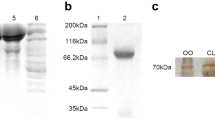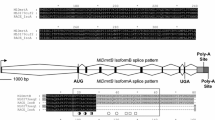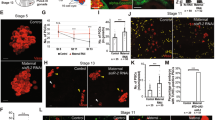Abstract
We investigated the mechanism by which germline cells are recruited in every asexual reproductive cycle of the budding tunicate Polyandrocarpa misakiensis using a vasa homolog (PmVas) as the germline-specific probe. A presumptive gonad of Polyandrocarpa arose as a loose cell aggregate in the ventral hemocoel of a 1-week-old developing zooid. It developed into a compact clump of cells and then separated into two lobes, each differentiating into the ovary and the testis. The ovarian tube that was formed at the bottom of the ovary embedded the oogonia and juvenile oocytes, forming the germinal epithelium. PmVas was expressed strongly by loose cell aggregates, compact clumps, and peripheral germ cells in the testis and germinal epithelium. No signals were detected in growing buds and less than 1-week-old zooids, indicating that germ cells arise de novo in developing zooids of P. misakiensis. Cells of the loose cell aggregates were 5–6 μm in diameter. They looked like undifferentiated hemoblasts in the hemocoel. To examine the involvement of PmVas in the germline recruitment at postembryonic stages, both growing buds and 1-week-old developing zooids were soaked with double-stranded PmVas RNA. The growing buds developed into fertile zooids expressing PmVas, whereas the 1-week-old zooids developed into sterile zooids that did not express PmVas. In controls (1-week-old zooids) soaked with double-stranded lacZ RNA, the gonad developed normally. These results strongly suggest that in P. misakiensis, PmVas plays a decisive role in switching from coelomic stem cells to germ cells.






Similar content being viewed by others
References
Berrill NJ (1940) The development of a colonial organism: symplegma viride. Biol Bull 79:272–281
Berrill NJ (1950) The tunicata with an account of the British species. Ray Society, London
Chomczynski P, Sacchi N (1987) Single-step method of RNA isolation by acid guanidinium thiocyanate-phenol-chloroform extraction. Anal Biochem 162:156–159
Frohman MA, Dush MK, Martin GR (1988) Rapid production of full-length cDNAs from rare transcripts: amplification using a single gene-specific oligonucleotide primer. Proc Natl Acad Sci USA 85:8998–9002
Fujimura M, Takamura K (2000) Characterization of an ascidian DEAD-box gene, Ci-DEAD1: specific expression in the germ cells and its mRNA localization in posterior-most blastomeres in early embryos. Dev Genes Evol 210:64–72
Gruidl ME, Smith PA, Kuznicki KA, Mccrone JS, Kirchner J, Roussell DL, Strome S, Bennett KL (1996) Multiple potential germline helicases are components of the germline-specific P granules of Caenorhabditis elegans. Proc Natl Acad Sci USA 93:13837–13842
Hay B, Ackerman L, Barbel S, Jan LY, Jan YN (1988a) Identification of a component of Drosophila polar granules. Development 103:625–640
Hay B, Jan LY, Jan YN (1988b) A protein component of Drosophila polar granules is encoded by vasa and has extensive sequence similarity to ATP-dependent helicases. Cell 55:577–587
Ikenishi K, Tanaka TS (1997) The cause of the decreased number of primordial germ cells in albino Xenopus resides not in the micro-environment but in the presumptive PGC. Dev Growth Differ 39:345–349
Illmensee K, Mahowald AP (1974) Transplantation of posterior polar plasm in Drosophila. Induction of germ cells at the anterior pole of the egg. Proc Natl Acad Sci USA 71:1016–1020
Izzard CS (1973) Development of polarity and bilateral asymmetry in the palleal bud of Botryllus schlosseri (Pallas). J Morphol 139:1–26
Kawamura K, Fujiwara S (1994) Transdifferentiation of pigmented multipotent epithelium during morphallactic development of budding tunicates. Int J Dev Biol 38:369–377
Kawamura K, Fujiwara S (1995) Cellular and molecular characterization of transdifferentiation in the process of morphallaxis of budding tunicates. Semin Cell Biol 6:17–26
Kawamura K, Nakauchi M (1991) Homeostatic integration of stem cell dynamics during palleal budding of ascidians. Zool Sci 8:11–22
Kawamura K, Fujiwara S, Sugino YM (1991) Budding-specific lectin induced in epithelial cells is an extracellular matrix component for stem cell aggregation in tunicates. Development 113:995–1005
Kiledjian M, Dreyfuss G (1992) Primary structure and binding activity of the hnRNP U protein: binding RNA through RGG box. EMBO J 11:2655–2664
Laird DJ, Chang WT, Weissman IL, Lauzon RJ (2005a) Identification of a novel gene involved in asexual organogenesis in the budding ascidian Botryllus schlosseri. Dev Dyn 234:997–1005
Laird DJ, De Tomaso AW, Weissman IL (2005b) Stem cells are units of natural selection in a colonial ascidian. Cell 123:1351–1360
Lasko PF, Ashburner M (1988) The product of the Drosophila gene vasa is very similar to eukaryotic initiation factor-4A. Nature 335:611–617
Lawson KA, Dunn NR, Roelen BA, Zeinstra LM, Davis AM, Wright CV, Korving JP, Hogan BL (1999) Bmp4 is required for the generation of primordial germ cells in the mouse embryo. Genes Dev 13:424–436
Manni L, Zaniolo G, Burighel P (1994) Ultrastructural study of oogenesis in the compound ascidian Botryllus schlosseri (Tunicate). Acta Zool (Stockholm) 75:101–113
Mochizuki K, Nishiyama-Fujisawa C, Fujisawa T (2001) Universal occurrence of the vasa-related genes among metazoans and their germline expression in Hydra. Dev Genes Evol 211:299–308
Mukai H, Watanabe H (1976) Studies on the formation of germ cells in a compound ascidian Botryllus primigenus Oka. J Morphol 148:337–362
Noce T, Okamoto-Ito S, Tsunekawa N (2001) Vasa homolog genes in mammalian germ cell development. Cell Struct Funct 26:131–136
Oka H, Watanabe H (1957) Vascular budding, a new type of budding in Botryllus. Biol Bull 112:225–240
Okada T, Yamamoto M (1993) Identification of early oogentic cells in the solitary ascidians, Ciona savignyi and Ciona intestinalis: an immunoelectron microscopic study. Dev Growth Differ 35:495–506
Pause A, Sonenberg N (1992) Mutational analysis of a DEAD box RNA helicase: the mammalian translation initiation factor eIF-4A. EMBO J 11:2643–2654
Pause A, Methot N, Sonenberg N (1993) The HRIGRXXR region of the DEAD box RNA helicase eukaryotic translation initiation factor 4A is required for RNA binding and ATP hydrolysis. Mol Cell Biol 13:6789–6798
Rajavashisth TB, Taylor AK, Andalibi A, Svenson KL, Lusis AJ (1989) Identification of a zinc finger protein that binds to the sterol regulatory element. Science 245:640–643
Raz E (2000) The function and regulation of vasa-like genes in germ-cell development. Genome Biol 1:1–6
Reynolds ES (1963) The use of lead citrate at high pH as an electron-opaque stain in electron microscopy. J Cell Biol 17:209–212
Rosner A, Paz G, Rinkevich B (2006) Divergent roles of the DEAD-box protein BS-PL10, the urochordate homologue of human DDX3 and DDX3Y proteins, in colony astogeny and ontogeny. Dev Dyn 235:1508–1521
Sabbadin A, Zaniolo G (1979) Sexual differentiation and germ cell transfer in the colonial ascidian Botryllus schlosseri. J Exp Zool 207:289–304
Sagawa K, Yamagata H, Shiga Y (2005) Exploring embryonic germline development in the water flea, Daphnia magna, by zinc-finger-containing VASA as a marker. Gene Expression Patterns 5:669–678
Shibata N, Umesono Y, Orii H, Sakurai T, Watanabe K, Agata K (1999) Exoression of vasa(vas)-related genes in germline cells and totipotent somatic stem cells of planalians. Dev Biol 206:73–87
Shirae-Kurabayashi M, Nishikata T, Takamura K, Tanaka KJ, Nakamoto C, Nakamura A (2006) Dynamic redistribution of vasa homolog and exclusion of somatic cell determinant during germ cell specification in Ciona intestinalis. Development 133:2683–2693
Spurr AR (1969) A low-viscosity epoxy resin embedding medium for electron microscopy. J Ultrastruct Res 26:31–43
Strome S, Wood WB (1983) Generation of asymmetry and segregation of germ-line granules in early C. elegans embryos. Cell 35:15–25
Sugino YM, Tsuji Y, Kawamura K (1993) An ultrastructural study of blood cells in the ascidian, Polyandrocarpa misakiensis: their classification and behavioral characteristics. Mem Fac Sci Kochi Univ (Ser D) 14:33–41
Sunanaga T, Saito Y, Kawamura K (2006) Postembryonic epigenesis of Vasa-positive germ cells from aggregated hemoblasts in the colonial ascidian, Botryllus primigenus. Dev Growth Differ 48:87–100
Tanaka SS, Toyooka Y, Akasu R, Katoh-Fukui Y, Nakahara Y, Suzuki R, Yokoyama M, Noce T (2000) The mouse homolog of Drosophila Vasa is required for the development of male germ cells. Genes Dev 14:841–853
Wakahara M (1996) Primordial germ cell development: is the urodele pattern closer to mammals than to anurans? Int J Dev Biol 40:653–659
Acknowledgment
We thank Mmes. Kayo Takeuchi and Yuko Tsuji for the preparation of specimens. We also thank Dr. Shigeki Fujiwara for valuable discussion and technical assistance throughout the course of study. Thanks are also due to the staff of the Usa Marine Research Center, Kochi University for providing facilities for the culture of animals.
Author information
Authors and Affiliations
Corresponding author
Additional information
Communicated by N. Satoh
Rights and permissions
About this article
Cite this article
Sunanaga, T., Watanabe, A. & Kawamura, K. Involvement of vasa homolog in germline recruitment from coelomic stem cells in budding tunicates. Dev Genes Evol 217, 1–11 (2007). https://doi.org/10.1007/s00427-006-0112-5
Received:
Accepted:
Published:
Issue Date:
DOI: https://doi.org/10.1007/s00427-006-0112-5




